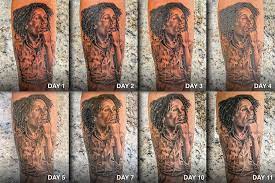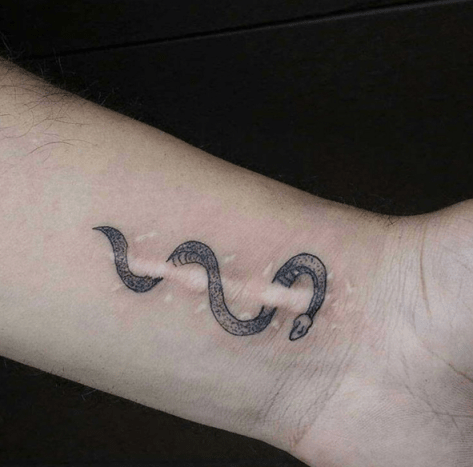
Tattoos are expressive marks that symbolize personal choices, traditions, and passages. They may also serve as memories, memorials, and tributes to loved ones who have passed.
Stage 1: Wound Healing
During the first stage, your body treats a tattoo like any other skin wound. It sends blood to the area to heal it and reduce soreness. Blood, plasma, or ink may be secreted for 48 to 72 hours. It’s important to avoid picking or rubbing at the oozing or flaky skin, as this can prolong healing and lead to scarring. Instead, use a tattoo-specific balm or ointment to soothe and moisturize the area. Itching is a natural part of this phase and should subside once oozing, bleeding, and redness disappear. However, the top layer of skin might start to peel, flake, and scab, causing more itching. Resisting the urge to scratch is crucial, as it can lead to infection or inflammation. Some ink may fade over time, but it is normal.
Stage 2: Itching
Itching may begin in the second week when scabs form and peel. It is important to avoid picking at or pulling off these scabs, as it can delay healing and cause scarring. Instead, use non-scented, antibacterial ointment or naturally-based tattoo balm to relieve and keep the skin hydrated. On a cellular level, your immune system works to prevent blood loss, form blood clots, ward off harmful bacteria, and heal broken tissue. The itching should have subsided by now, and redness or swelling should have been reduced. Healing continues months after getting the tattoo, so taking care of your body through a healthy diet, hydration, and rest is essential.
Stage 3: Peeling
During stage 3, the scabbing starts to heal and naturally peel away, usually within seven days. New skin is delicate and sensitive to sun exposure, so wearing protection is crucial. It is common for Tattoos to continue itching even after healing. Applying a soothing lotion can provide temporary relief. Tattoos may appear hazy or cloudy due to blood and fluids moving through them into newly formed tissues, leaving an inky hue on the surface. This effect occurs as circulation takes place within the newly created cells. If the scabbing and peeling are severe, seeking medical advice or consulting your tattoo artist or doctor is necessary. Avoid physically removing scabs or peeling skin, as it can result in scarring. Maintain twice daily washing and regular application of non-scented ointment or naturally-based anti-inflammatory balm to keep the tattoo infection-free and looking its best.
Taking care of your tattoo during its healing stages is crucial for proper recovery and avoiding complications. By following the necessary precautions and paying attention to any signs of infection, you can ensure your tattoo heals beautifully and becomes a lasting symbol of personal significance.

